
An Erlenmeyer flask, also known as a conical flask or a titration flask, is a type of laboratory flask which features a flat bottom, a conical body, and a cylindrical neck. It is named after the German chemist Emil Erlenmeyer (1825–1909), who created it in 1860.

Laboratory glassware refers to a variety of equipment used in scientific work, and traditionally made of glass. Glass can be blown, bent, cut, molded, and formed into many sizes and shapes, and is therefore common in chemistry, biology, and analytical laboratories. Many laboratories have training programs to demonstrate how glassware is used and to alert first–time users to the safety hazards involved with using glassware.

A test tube, also known as a culture tube or sample tube, is a common piece of laboratory glassware consisting of a finger-like length of glass or clear plastic tubing, open at the top and closed at the bottom.

A toothbrush is an oral hygiene instrument used to clean the teeth, gums, and tongue. It consists of a head of tightly clustered bristles, atop of which toothpaste can be applied, mounted on a handle which facilitates the cleaning of hard-to-reach areas of the mouth. They should be used in conjunction with something to clean between the teeth where the bristles of the toothbrush cannot reach - for example floss, tape or interdental brushes.

A brush is a common tool with bristles, wire or other filaments. It generally consists of a handle or block to which filaments are affixed in either a parallel or perpendicular orientation, depending on the way the brush is to be gripped during use. The material of both the block and bristles or filaments is chosen to withstand hazards of its intended use, such as corrosive chemicals, heat or abrasion. It is used for cleaning, grooming hair, make up, painting, surface finishing and for many other purposes. It is one of the most basic and versatile tools in use today, and the average household may contain several dozen varieties.
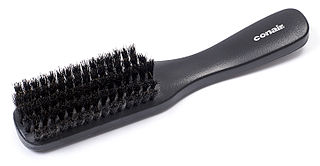
A hairbrush is a handle brush with rigid or soft spokes used in hair care for smoothing, styling, and detangling human hair, or for grooming an animal's fur. It can also be used for styling in combination with a curling iron or hair dryer.

A volumetric flask is a piece of laboratory apparatus, a type of laboratory flask, calibrated to contain a precise volume at a certain temperature. Volumetric flasks are used for precise dilutions and preparation of standard solutions. These flasks are usually pear-shaped, with a flat bottom, and made of glass or plastic. The flask's mouth is either furnished with a plastic snap/screw cap or fitted with a joint to accommodate a PTFE or glass stopper. The neck of volumetric flasks is elongated and narrow with an etched ring graduation marking. The marking indicates the volume of liquid contained when filled up to that point. The marking is typically calibrated "to contain" at 20 °C and indicated correspondingly on a label. The flask's label also indicates the nominal volume, tolerance, precision class, relevant manufacturing standard and the manufacturer's logo. Volumetric flasks are of various sizes, containing from 1 milliliter to 20 liters of liquid.
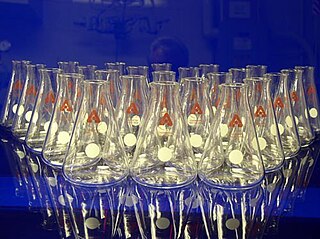
Laboratory flasks are vessels or containers that fall into the category of laboratory equipment known as glassware. In laboratory and other scientific settings, they are usually referred to simply as flasks. Flasks come in a number of shapes and a wide range of sizes, but a common distinguishing aspect in their shapes is a wider vessel "body" and one narrower tubular sections at the top called necks which have an opening at the top. Laboratory flask sizes are specified by the volume they can hold, typically in metric units such as milliliters or liters. Laboratory flasks have traditionally been made of glass, but can also be made of plastic.

The Babcock test is an inexpensive and practical procedure to determine the fat content of milk. It is named after its developer, Stephen M. Babcock (1843–1931), professor at the University of Wisconsin.
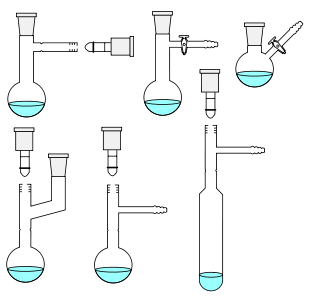
A Schlenk flask, or Schlenk tube, is a reaction vessel typically used in air-sensitive chemistry, invented by Wilhelm Schlenk. It has a side arm fitted with a PTFE or ground glass stopcock, which allows the vessel to be evacuated or filled with gases. These flasks are often connected to Schlenk lines, which allow both operations to be done easily.

Ground glass joints are used in laboratories to quickly and easily fit leak-tight apparatus together from interchangeable commonly available parts. For example, a round bottom flask, Liebig condenser, and oil bubbler with ground glass joints may be rapidly fitted together to reflux a reaction mixture. This is a large improvement compared with older methods of custom-made glassware, which was time-consuming and expensive, or the use of less chemical resistant and heat resistant corks or rubber bungs and glass tubes as joints, which took time to prepare as well.
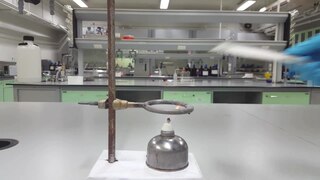
A wire gauze is a sheet of thin metal that has net-like patterns or a wire mesh. Wire gauze is placed on the support ring that is attached to the retort stand between the Bunsen burner and the glassware to support the beakers, flasks, or other glassware during heating. Wire gauze is an important piece of supporting equipment in a laboratory as glassware cannot be heated directly with the flame of a Bunsen burner, and requires the use of a wire gauze to diffuse the heat, helping to protect the glassware. Glassware has to be flat-bottomed to stay on the wire gauze.
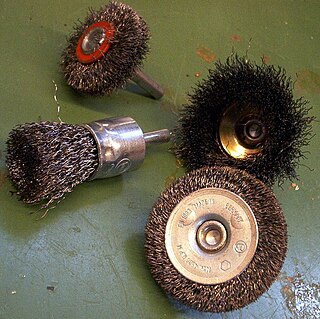
A wire brush is a tool consisting of a brush whose bristles are made of wire, most often steel wire. The steel used is generally a medium- to high-carbon variety and very hard and springy. Other wire brushes feature bristles made from brass or stainless steel, depending on application. Wires in a wire brush can be held together by epoxy, staples, or other binding. Wire brushes usually either have a handle of wood or plastic or are formed into a wheel for use on angle grinders, bench grinders, pistol-grip drill motors, or other power tools.
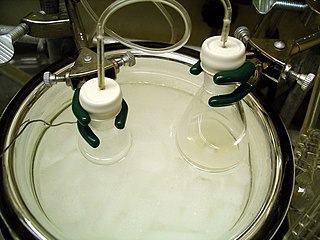
Cannula transfer or cannulation is a set of air-free techniques used with a Schlenk line, in transferring liquid or solution samples between reaction vessels via cannulae, avoiding atmospheric contamination. While the syringes are not the same as cannulae, the techniques remain relevant.

In chemistry, a retort stand, also called a clamp stand, a ring stand, or a support stand, is a piece of scientific equipment intended to support other pieces of equipment and glassware — for instance, burettes, test tubes and flasks.

A paintbrush is a brush used to apply paint or sometimes ink. A paintbrush is usually made by clamping the bristles to a handle with a ferrule. They are available in various sizes, shapes, and materials. Thicker ones are used for filling in, and thinner ones are used for details. They may be subdivided into decorators' brushes used for painting and decorating and artists' brushes use for visual art.

Laboratory drying rack is a pegboard for hanging and draining glassware in a laboratory. It is available in different varieties and sizes. It can be used for different materials of glassware in the laboratory room such as funnels, pipettes, mixing balls, slides, bottle stoppers, tubing and so on. In addition to that, the pegs on the drying rack are easily removable and replaceable in order to maintain the cleaning of the lab racks to avoid contamination with other apparatus used on the same rack. Any common laboratory needs to have at least two or three drying racks per lab.

A Babcock bottle is a clear glass flask with a long graduated neck, used in the Babcock test to evaluate the cream contents of milk. It is also called a Babcock milk test bottle, milk test bottle, cream test bottle, and other similar names.
Louis Firth Nafis was an American entrepreneur and inventor, best known as the first manufacturer of the standard Babcock milk test bottle. He was born in Jersey City, New Jersey on November 1, 1884, and died on February 26, 1955, in Evanston, Illinois.




















